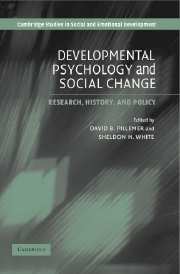Book contents
- Frontmatter
- Contents
- Preface
- List of Contributors
- Introduction: What Kind of Science Is Developmental Psychology?
- Part One The Developing Child: Global and Historical Perspectives
- Part Two Designing Child and Family Policies
- Part Three Designing Child Health Policies
- Part Four Designing Effective Learning Environments for Children and Adolescents
- 9 A Cultural/Historical View of Schooling in Human Development
- 10 The Rise of the American Nursery School: Laboratory for a Science of Child Development
- 11 Actualizing Potentials: Learning through Psychology's Recurrent Crises
- 12 The Rise of a Right-Wing Culture among German Youth: The Effects of Social Transformation, Identity Construction, and Context
- 13 Learning Potential Assessment: Where Is the Paradigm Shift?
- 14 Teaching as a Natural Cognitive Ability: Implications for Classroom Practice and Teacher Education
- Index
- References
14 - Teaching as a Natural Cognitive Ability: Implications for Classroom Practice and Teacher Education
Published online by Cambridge University Press: 03 December 2009
- Frontmatter
- Contents
- Preface
- List of Contributors
- Introduction: What Kind of Science Is Developmental Psychology?
- Part One The Developing Child: Global and Historical Perspectives
- Part Two Designing Child and Family Policies
- Part Three Designing Child Health Policies
- Part Four Designing Effective Learning Environments for Children and Adolescents
- 9 A Cultural/Historical View of Schooling in Human Development
- 10 The Rise of the American Nursery School: Laboratory for a Science of Child Development
- 11 Actualizing Potentials: Learning through Psychology's Recurrent Crises
- 12 The Rise of a Right-Wing Culture among German Youth: The Effects of Social Transformation, Identity Construction, and Context
- 13 Learning Potential Assessment: Where Is the Paradigm Shift?
- 14 Teaching as a Natural Cognitive Ability: Implications for Classroom Practice and Teacher Education
- Index
- References
Summary
This is a chapter about why we teach. I do not ask what the best way is to teach this subject matter or that. Nor do I ask how we can assess children's learning as a result of teaching. Instead, I ask a deceptively simple question: Why do we teach in the first place? The search for answers to that question takes us to the borders between our biological, psychological, and cultural endowment as humans.
Teaching, or folk pedagogy, the social transformation of knowledge from one person to another or the attempt to engender it in others, is one of the most remarkable of human enterprises. I propose that teaching, which is central to education in the broad sense of that term, can also be seen as an essential domain of inquiry for the cognitive sciences. This is so because, as I attempt to show, teaching may be a natural cognitive ability and is essential to what it means to be a human being. Furthermore, I believe that a search for the cognitive underpinnings of teaching may lead to a description of some of the fundamental building blocks of human cognition and its development.
Learning, teaching's mirror image, has been a major focus of the cognitive sciences, to be sure, but intentional pedagogy aimed to cause learning has, by and large, been flying below the cognitive sciences' radar.
- Type
- Chapter
- Information
- Developmental Psychology and Social ChangeResearch, History and Policy, pp. 368 - 388Publisher: Cambridge University PressPrint publication year: 2005
References
- 32
- Cited by



